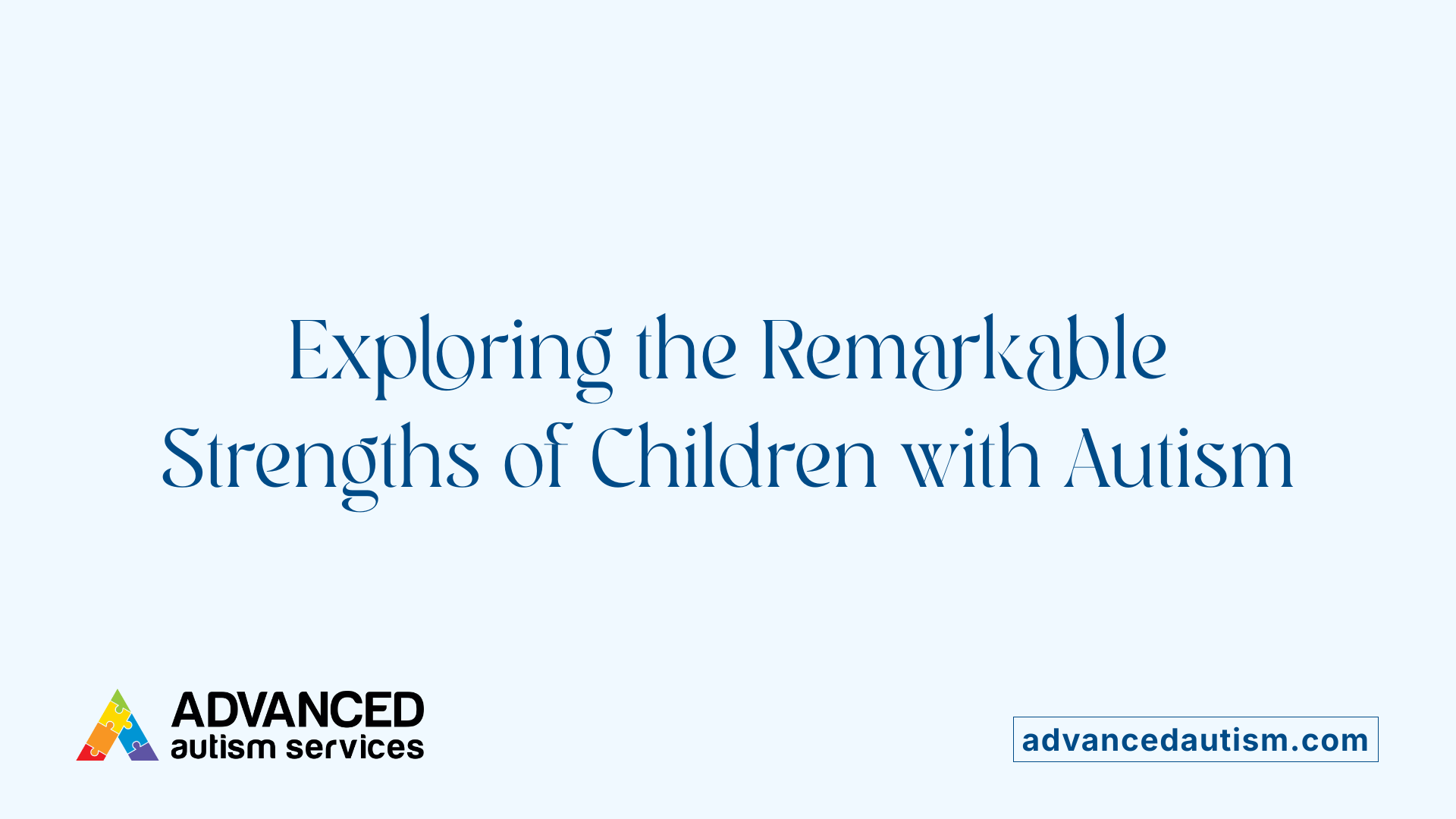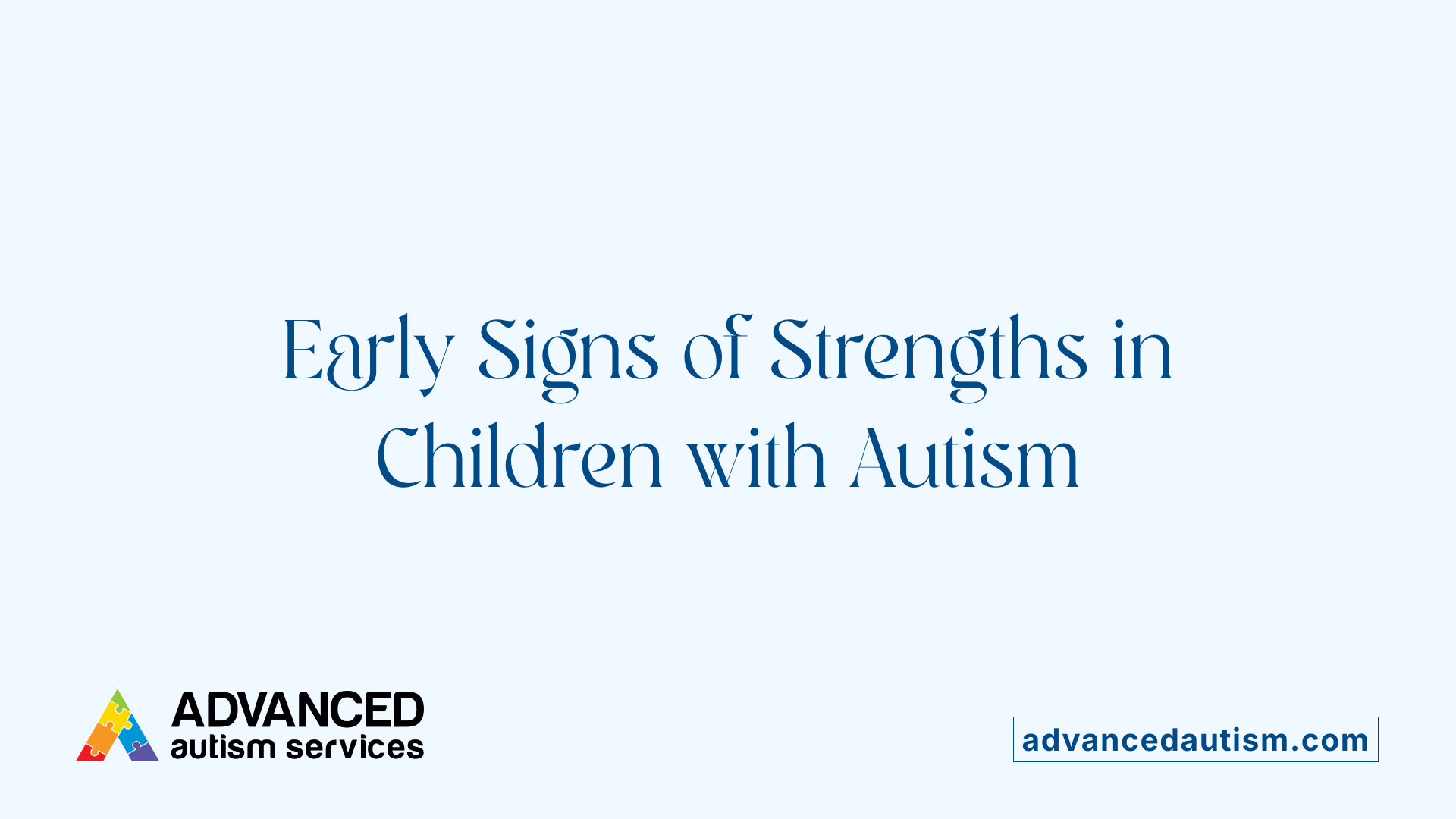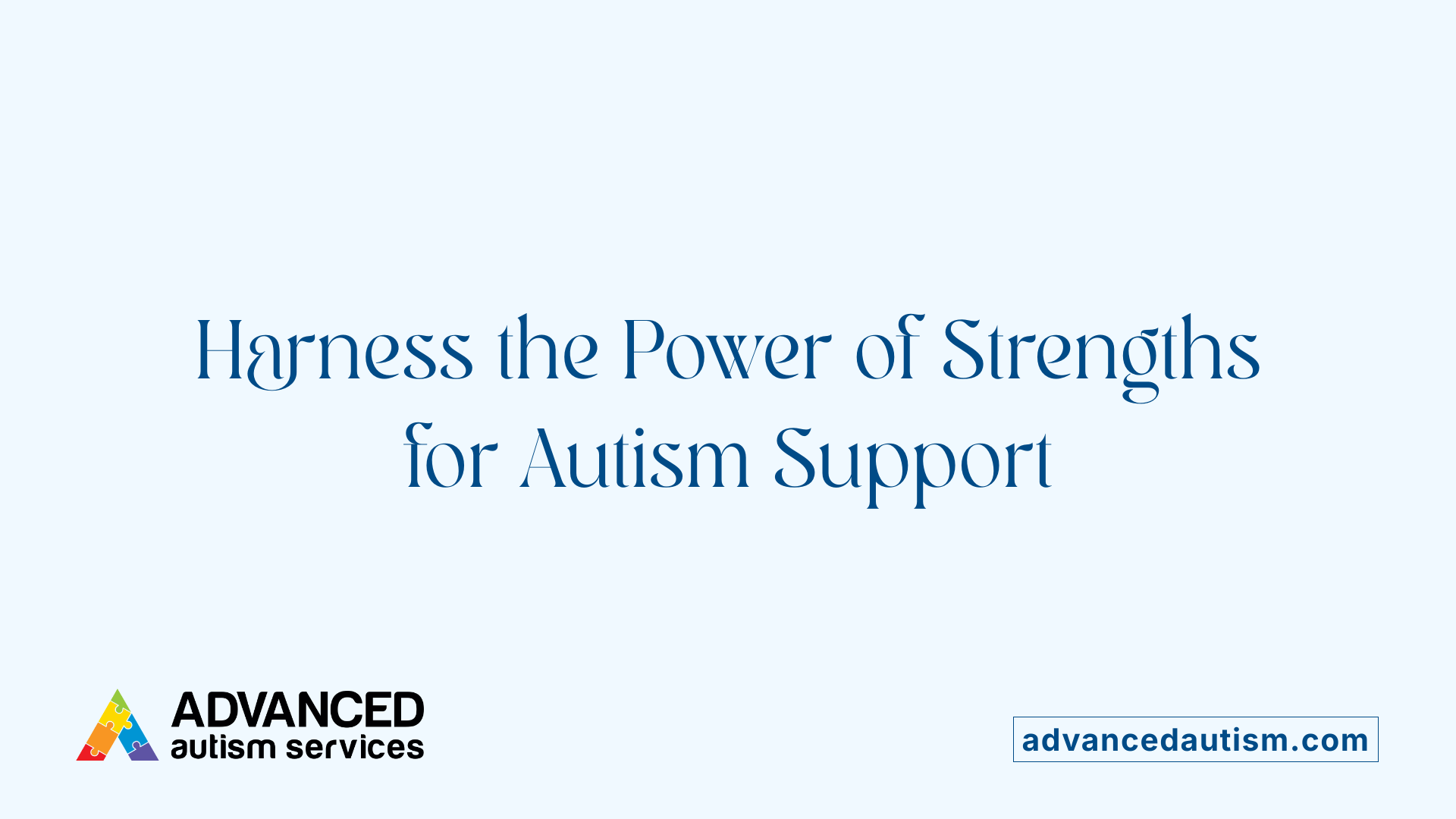How to Identify Strengths in Children with Autism
Celebrating Potential: Unlocking the Strengths of Children with Autism
Understanding and Appreciating Autistic Strengths
Autism Spectrum Disorder (ASD) is often viewed through the lens of challenges; however, recognizing and nurturing the inherent strengths of children with autism is crucial for fostering their development and well-being. By shifting the focus from deficits to abilities, caregivers, educators, and professionals can create supportive environments that emphasize potential and empower autistic children to thrive. This article explores comprehensive strategies and insights to identify, support, and cultivate the unique strengths of children with autism, helping them reach their full potential.
Understanding Typical Autistic Strengths

What are the typical strengths observed in children with autism?
Children with autism often display a variety of remarkable strengths that can shape their development and contributions across many areas. One of the most prominent characteristics is their tendency to develop deep expertise and intense focus on their special interests. These interests can be highly specific, leading to advanced skills and knowledge in subjects such as science, arts, music, or technology. For example, a child might become proficient in topics like dinosaurs, space, or computer programming through dedicated engagement.
Another significant strength is their exceptional attention to detail and pattern recognition capabilities. Autistic children are often highly perceptive, noticing subtle changes in their environment that might escape others. They excel in visual-spatial reasoning, with heightened sensory sensitivities including perfect pitch, acute hearing, and heightened visual perception. These perceptual abilities contribute to their talent in tasks like visual searches or distinguishing complex sensory stimuli, such as recognizing mixed smells or color nuances.
Memory skills are frequently cited as a core strength among autistic individuals. They may possess excellent long-term memory, vivid recall of facts and dates, and the ability to learn rapidly. This encyclopedic memory allows for recall of intricate details and supports their learning processes across various domains, including academics and everyday life. However, such memory can sometimes be a challenge when traumatic or distressing memories are involved.
Creative problem-solving is another hallmark characteristic. Autistic people often demonstrate innovative thinking and excellent reasoning skills, especially in pattern recognition and logical thinking. Their ability to think laterally or systemize information helps them devise effective and novel solutions to complex problems. Many excel in creating systems and routines that enhance organization and reasoning, benefiting both personal and professional activities.
Character traits such as honesty, loyalty, and a strong sense of justice are frequently reported. Autistic children tend to be trustworthy, dependable, and motivated by fairness and ethical principles. Their honesty fosters trustworthiness, and their loyalty makes them committed friends and reliable colleagues. This sense of justice can motivate them to advocate for what they believe is right, contributing to social integrity and moral development.
In summary, children with autism have a distinctive array of strengths. These include deep expertise fueled by focused interests, exceptional visual and auditory perception, impressive memory, innovative problem-solving skills, and dependable character qualities. Recognizing and nurturing these abilities can greatly support their growth, empowerment, and societal contributions, illustrating how unique and valuable their perspectives are.
Identifying Strengths in Children with Autism

How can caregivers and educators identify and support the strengths of children with autism?
Recognizing the unique strengths of children with autism involves careful observation and an understanding of their behaviors, interests, and how they engage with their environment. Caregivers and educators should pay close attention to the activities that naturally draw the child’s attention and where they show enthusiasm or competence.
For example, some children may display heightened skills in visual perception, excel in memory, or demonstrate exceptional focus. They might have intense interests in areas like technology, art, music, or science. These passions often serve as avenues for social bonding and stress relief, making it essential to nurture and develop them.
Observing how children operate in different settings—home, school, or social groups—can reveal strengths that might not be obvious initially. They might show remarkable attention to detail, creative problem-solving abilities, or loyalty and honesty in their interactions.
In addition to informal observation, structured assessments are useful tools. The Survey of Autistic Strengths, Skills, and Interests (SASSI) is an example that helps professionals identify areas of competence systematically. This checklist explores categories like cognitive skills, social abilities, hobbies, character traits, and physical talents.
Utilizing visual aids, activity kits, and tailored learning modules can help highlight and develop these strengths. For instance, creative activities like drawing or music can reveal musical talent or artistic ability, while logical puzzles can showcase pattern recognition and problem-solving skills.
Supporting children involves creating environments that celebrate their talents. Encouraging participation in hobbies and providing opportunities to excel fosters self-esteem and motivation.
A strengths-based approach emphasizes the importance of observing with care, acknowledging talents regularly, and designing interventions that build on these positive qualities. This method not only nurtures personal growth but also enhances social and emotional development.
Techniques and tools for identifying and nurturing strengths
| Technique | Description | Purpose |
|---|---|---|
| Developmental observations | Monitoring behaviors and interests across settings | Spotting long-term talents and inclinations |
| Structured assessments (e.g., SASSI) | Using validated tools to evaluate skills and traits | Systematic identification of strengths |
| Activity-based discovery | Engaging children in diverse activities to observe their responses | Highlighting talents through rehearsal |
| Positive reinforcement and feedback | Providing praise and encouragement based on observed strengths | Building confidence and motivation |
| Visual aids and adaptive tools | Using pictures, charts, or specialized equipment to explore abilities | Clarifying talents and supporting engagement |
Examples of areas where children with autism can exhibit strengths
- Artistic and musical abilities
- Exceptional memory and attention to detail
- Logical reasoning and pattern recognition
- Loyalty, honesty, and reliability
- Physical skills such as coordination and motor precision
- Systematic thinking in routines and organizing
Supporting these strengths begins with patience, consistent reinforcement, and collaboration among caregivers, teachers, and specialists. Tailoring educational activities and social opportunities to these areas can foster confidence and unlock potential.
How do structured assessments like SASSI assist?
Tools like SASSI provide a comprehensive way to identify and categorize strengths that might otherwise go unnoticed. They explore dimensions such as cognitive and social qualities, special interests, resilience, and character traits.
In practice, integrating these assessments with ongoing observations helps create a fuller picture of a child's abilities. They guide personalized learning plans, fostering growth in areas most meaningful and natural for each individual.
By regularly recognizing and fostering these strengths, we support children’s overall development and help prepare them for future success. Building on what children already excel at can be a powerful motivator and a foundation for lifelong learning and fulfillment.
Recognizing Developmental Signs of Positive Traits

What developmental signs indicate positive traits or strengths in children with autism?
Children with autism often display unique developmental clues that highlight their strengths and potential. Recognizing these signs early on can help caregivers and educators nurture their talents and improve their quality of life.
One prominent indicator is the presence of advanced or highly specialized skills. For example, some children may develop exceptional abilities in areas like music, where they exhibit perfect pitch or musical memory. Others might demonstrate remarkable visual attention, quickly noticing detailed patterns or details that others overlook. These skills often reflect their innate perceptual strengths and can serve as the foundation for further growth.
A strong focus and persistence are also signs of positive traits. Many autistic children can concentrate intensely on tasks or interests that captivate them. This hyperfocus enables them to achieve high levels of mastery in specific areas, such as assembling complex puzzles, memorizing facts, or coding in computer programming. Their dedication and resilience often lead to significant accomplishments.
Appropriate social interactions, such as sharing interests or responding correctly to social cues, can indicate social strengths. For example, a child who eagerly discusses their favorite topic or skill with others demonstrates an ability to connect and communicate in meaningful ways. Recognizing playful or reciprocal engagement helps identify social competencies that may not be immediately obvious.
Indicators of responsiveness and engagement encompass how children react to their environment and interact with others. Children displaying curiosity, asking questions, or showing enthusiasm when introduced to new activities reveal their eagerness to learn and participate. Engaged children often retain information well and are motivated to expand their skills.
Identifying these developmental signs of strengths is crucial. It allows caregivers and professionals to tailor educational strategies that leverage a child's innate talents. Such an approach fosters confidence, enhances motivation, and promotes long-term success.
By focusing on what children can do well, we move toward a more balanced understanding of autism. Strength-based recognition encourages societal acceptance and underscores the importance of supporting each child's unique potential.
| Developmental Signs | Examples | Benefits |
|---|---|---|
| Advanced skills | Musical talent, exceptional memory | Builds confidence, opens career doors |
| Focus and persistence | Mastering puzzles, coding | Promotes resilience and self-efficacy |
| Positive social behaviors | Sharing interests, reciprocal play | Enhances social integration |
| Engagement indicators | Curiosity, enthusiasm | Fosters motivation and learning |
Through awareness and observation of these signs, caregivers can better support children with autism in reaching their full potential. Appreciating these traits shifts focus from challenges to strengths, encouraging a more inclusive and nurturing environment.
The Importance of Strengths-Based Assessments

Why are strengths-based assessments important for children with autism?
Strengths-based assessments play a crucial role in supporting children on the autism spectrum by recognizing and emphasizing their unique abilities, talents, and positive traits rather than focusing solely on their challenges. These assessments shift the narrative from deficits to possibilities, fostering a more empowering perspective for children, families, and educators.
By identifying strengths such as exceptional memory, creativity, attention to detail, or specific interests, caregivers and professionals can develop tailored strategies that nurture these skills. For example, a child with notable visual perception might excel in art or pattern recognition, opening pathways for confidence-building activities and educational engagement.
Supporting individualized development through such assessments ensures that each child's potential is acknowledged and cultivated. This approach aligns with current clinical and research initiatives that endorse respecting the autonomy and competence of autistic individuals. When interventions target strengths, they tend to be more engaging and effective, enabling children to build on their natural aptitudes.
Moreover, strengths-based evaluations contribute to better social and emotional outcomes. When children see their abilities recognized and celebrated, their self-esteem and motivation improve, fostering resilience and a positive outlook toward learning and social participation.
Aligning support strategies with identified strengths also facilitates long-term success in education and employment. For instance, a child with keen pattern recognition might thrive in STEM fields or data management, guiding career planning from a young age.
Fostering self-esteem and motivation is particularly vital because many autistic children encounter barriers rooted in conventional deficit-focused systems. Recognizing and nurturing their strengths helps challenge stigmatization and societal stereotypes, promoting inclusion and acceptance.
In summary, strengths-based assessments are more than diagnostic tools; they are fundamental in unlocking the full potential of autistic children, supporting their growth, happiness, and active participation in society.
Practical Strategies to Support Strengths Development
What practical strategies can be used to support and develop the strengths of children with autism?
Supporting and nurturing the unique abilities of children with autism begins with understanding their individual strengths. One effective way to do this is by using assessment tools like the Survey of Autistic Strengths, Skills, and Interests (SASSI), which helps identify specific talents, passions, and character traits. These insights provide a foundation for tailored intervention plans that recognize each child’s potential.
Visual learning and structured routines are particularly beneficial for autistic children. Many exhibit strengths in visual-spatial reasoning, pattern recognition, and systematic thinking. Implementing visual aids, charts, and step-by-step routines helps them process information more effectively, reducing anxiety and promoting independence. Creating predictable daily schedules also supports their need for order and consistency, enabling them to focus and succeed.
Leveraging special interests is another powerful strategy. Children often develop intense passions such as space, dinosaurs, or music, which can be harnessed to enhance their skills in social communication, numeracy, language, and problem-solving. For example, using their interest in astronomy to teach mathematical concepts or science encourages engagement while cultivating competence.
Incorporating sensory strengths and pattern recognition talents into learning experiences can markedly improve outcomes. Many autistic individuals have heightened visual perception, auditory discrimination, or olfactory sensitivities. Designing activities that utilize these sensory abilities, such as visual searches or musical pattern exercises, can foster confidence and independence.
Creating inclusive environments is essential for sustaining progress. This involves promoting understanding and acceptance among peers and educators, employing naturalistic teaching methods that embed learning into everyday contexts, and encouraging peer interactions through guided play and social groups. Such environments enhance social skills, build trust, and affirm the value of autistic traits.
In summary, practical strategies involve early assessment, visual routines, the creative use of special interests, sensory-rich activities, and inclusive supports. When these approaches are combined within a supportive environment, they empower children with autism to develop their strengths fully, leading to lasting benefits in education, social participation, and personal growth.
Educational and Societal Significance of Recognizing Strengths
What are some key insights into the significance of strengths in the educational development of children with autism?
Recognizing and nurturing the unique strengths of children with autism can transform their educational experiences. These strengths — including exceptional memory, creative talents, attention to detail, and intense interests — serve as powerful tools to enhance engagement and foster a love for learning.
Early identification of individual abilities allows educators and parents to develop personalized learning plans that align with each child's natural talents. For instance, a child with a keen eye for visual details might excel in art, scientific observation, or pattern recognition activities. By cultivating these skills early, children build confidence and stay motivated to learn.
Supportive, adaptable environments play an essential role. When schools create diverse opportunities such as hands-on projects, creative outlets, and interest-based tasks, children are more likely to participate actively. These settings help unveil hidden talents and develop skills that extend beyond academics.
Parental involvement is equally vital. Parents who understand and encourage their child’s interests contribute to a positive feedback loop that strengthens motivation and self-esteem. Collaborative efforts between families and teachers amplify the effectiveness of strength-based strategies.
This approach not only improves immediate educational outcomes but also sets the foundation for lifelong success. Children learn to leverage their abilities in real-world settings, paving the way for future employment, social integration, and personal fulfillment.
Ultimately, embracing a strengths-focused perspective in education encourages societal acceptance of neurodiversity. It shifts the narrative from deficits to potentials, fostering an inclusive culture that values different ways of thinking and perceiving the world.
| Aspect | Impact | Example |
|---|---|---|
| Engagement and Motivation | Increased interest and sustained participation | A child with special interests in space builds knowledge and explores related careers |
| Personalized Learning | Tailored support enhances individual growth | Small group activities tailored to a child's focus area, like music or puzzles |
| Long-term Development | Skills built today lead to future opportunities | Developing social communication through shared interests and teamwork |
| Societal Inclusion | Promoting respect for neurodiversity | Media and community programs highlighting strengths of autistic individuals |
Supporting children through a strengths-based lens ultimately equips them with the tools, confidence, and opportunities needed to thrive in a complex world. It fosters an environment where diversity of thought and ability is celebrated, helping society to move towards inclusion and equity.
Expert Advice on Recognizing and Utilizing Strengths
How can professionals and caregivers recognize and utilize autistic strengths effectively?
Experts emphasize the importance of active observation and individualized assessment. Each autistic person has a unique profile of talents and characteristics, including passions, creativity, detailed visual or auditory perception, and strong memory skills. By carefully observing behaviors, interests, and responses, caregivers and professionals can identify these strengths early. Modern assessment tools, such as the Child Autism and Neurodevelopment Strengths Checklist (CANS), provide structured ways to document and interpret positive attributes and skills.
Creating supportive environments is another cornerstone of unlocking potential. Providing opportunities that align with the individual's interests—such as art projects, music, puzzles, or technical activities—allows strengths to develop naturally. For instance, engaging a child with a passion for patterns and puzzles can enhance problem-solving skills and confidence.
Supporting sensory and character strengths is equally vital. Many autistic individuals excel in visual, auditory, or olfactory perception. Ensuring access to sensory-friendly spaces, or tools that mitigate overload, helps individuals function at their best. Recognizing character qualities such as honesty, loyalty, and a strong sense of justice can foster self-esteem and reinforce positive identities.
Positive reinforcement and encouragement are fundamental strategies. Praising efforts, celebrating interests, and providing constructive feedback help build confidence. When a child demonstrates persistence or creativity, acknowledging these traits motivates further growth.
Finally, a tailored, strengths-based approach incorporates these insights into meaningful interventions. This might include integrating preferred activities into therapy, designing educational plans around individual passions, and involving the individual in decision-making processes. Such strategies not only enhance skills but also promote a positive sense of self and well-being.
Overall, expert advice highlights that recognizing and nurturing strengths requires patience, attentive observation, and flexible support systems. These measures ensure that autistic individuals can achieve their full potential and experience a sense of competence and belonging.
Embracing a Strengths-Centered Perspective
Recognizing and nurturing the strengths of children with autism is not just beneficial but essential for fostering their development, confidence, and societal integration. A strengths-based approach supports personalized interventions that unlock each child's unique potential and promotes a more inclusive understanding of autism. By emphasizing abilities and talents, caregivers and educators can help children develop resilience, independence, and a positive self-identity. Celebrating neurodiversity and focusing on strengths pave the way for a more accepting society, where autistic individuals are valued for their contributions and capacities, enriching communities and inspiring future generations.
References
- Autistic strengths | Autistica
- Autism strengths & Challenges | Embrace Autism
- Strengths of Autistic Children | Sunfield Center
- the survey of autistic strengths, skills, and interests - PMC
- Understanding the Unique Strengths in Children With Autism
- Strengths that Come with Autism and Why You Should Care | Otsimo
- Finding strengths in autism - The Transmitter
- Autism Strengths: How to Develop Your Child's Unique Abilities
- The self-identified positive attributes and favourite activities of ...
- Focus on strengths as well as challenges | Autistica







